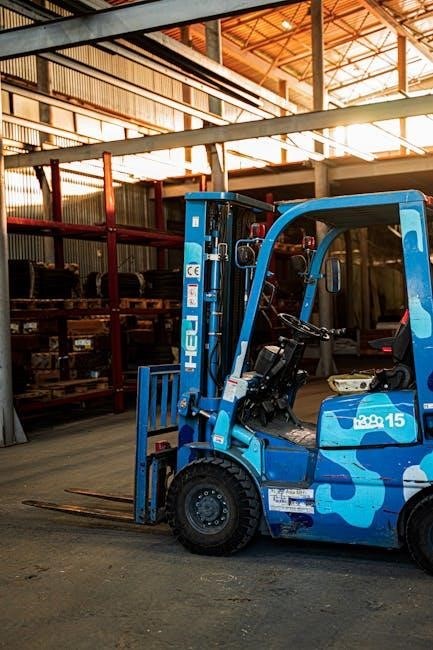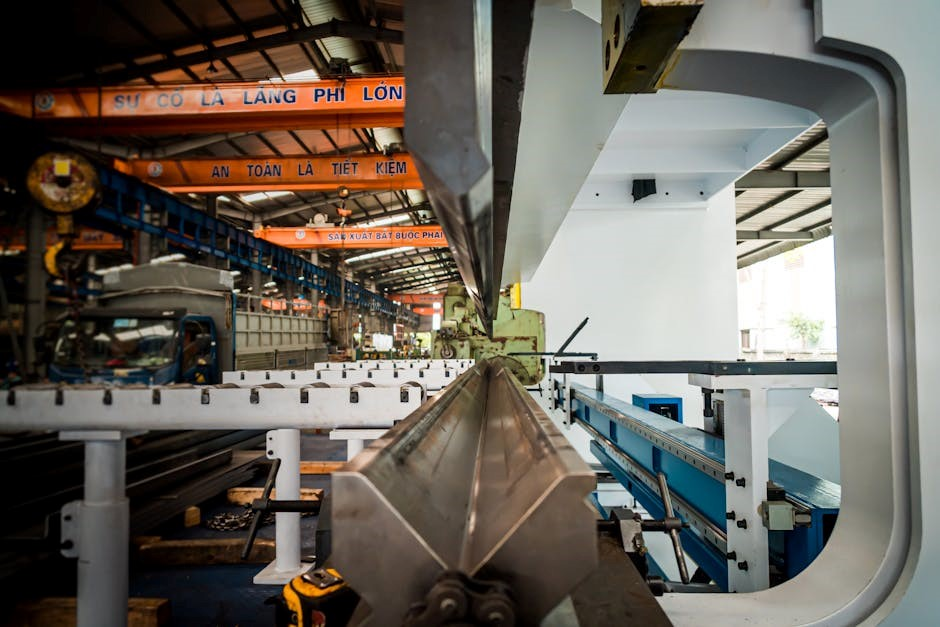Automated Guided Vehicles (AGVs) are intelligent, unmanned transport systems that navigate using predefined paths or sensors, optimizing material handling in manufacturing, logistics, and healthcare. They enhance efficiency, safety, and scalability in Industry 4.0 environments.
1.1 Definition and Overview
Automated Guided Vehicles (AGVs) are unmanned, computer-controlled transport systems designed to move materials, goods, or equipment within industrial environments. They operate without human intervention, navigating predefined paths using sensors, magnets, or vision systems. AGVs are widely used in manufacturing, logistics, and healthcare to streamline workflows, reduce errors, and enhance operational efficiency. These vehicles are equipped with advanced navigation technologies, enabling them to adapt to dynamic environments and perform tasks like pallet transportation, assembly line feeding, and warehouse management. By integrating automation, AGVs minimize labor costs, improve safety, and increase productivity, making them essential tools in modern Industry 4.0 ecosystems. Leading manufacturers like Dematic and KUKA have pioneered innovative AGV solutions tailored to diverse industrial needs.
1.2 Historical Development
Automated Guided Vehicles (AGVs) have evolved significantly since their introduction in the mid-20th century. Early systems, developed in the 1950s, relied on simple wire-guided navigation, limiting their flexibility. The 1980s saw advancements in sensor technologies, enabling AGVs to operate more autonomously. Modern AGVs now utilize cutting-edge navigation systems, such as vision guidance and SLAM (Simultaneous Localization and Mapping), allowing them to adapt to dynamic environments. The integration of AI and Industry 4.0 technologies has further enhanced their capabilities, making AGVs indispensable in modern manufacturing and logistics. This historical progression reflects continuous innovation, driven by industry leaders like Dematic and KUKA, who have pioneered advancements in AGV technology.
1.3 Importance in Modern Industry
Automated Guided Vehicles (AGVs) play a pivotal role in modern industry by enhancing operational efficiency, reducing costs, and improving safety. Their ability to navigate autonomously allows for 24/7 operation, minimizing downtime and maximizing throughput. AGVs are particularly valuable in manufacturing, logistics, and healthcare, where precise material handling is critical. By integrating with Industry 4.0 technologies, AGVs enable real-time data processing, optimizing supply chain management. Their scalability and adaptability make them essential for industries facing increasing demand for rapid and accurate order fulfillment. As automation advances, AGVs are becoming indispensable in achieving lean manufacturing goals and maintaining competitive advantage in global markets.

Market Overview of AGV Manufacturers
The AGV market is rapidly expanding due to rising demand for automation in manufacturing and logistics. Key manufacturers like Dematic and KUKA lead innovation and adoption globally.
2.1 Global Market Size and Growth
The global AGV market has experienced significant growth, driven by increasing automation demands in industries like manufacturing and logistics. In 2023, the market size surpassed $5 billion, with a compound annual growth rate (CAGR) of 12%. This expansion is fueled by technological advancements, such as improved navigation systems and integration with Industry 4.0. Key manufacturers like Dematic and KUKA are investing heavily in research and development to meet rising demand. The market is expected to continue growing steadily, reaching $10 billion by 2030, as more companies adopt AGVs to enhance operational efficiency and reduce costs.

2.2 Key Industry Trends
The AGV market is witnessing significant trends, including the integration of artificial intelligence and machine learning for enhanced navigation and decision-making. Sustainability is another key focus, with manufacturers developing energy-efficient models to reduce environmental impact. The rise of Industry 4.0 has accelerated the adoption of AGVs, enabling seamless integration with smart factories and logistics systems. Additionally, there is a growing emphasis on customization, with manufacturers offering tailored solutions to meet specific industry needs. Investments in research and development are driving innovation, while the demand for safer and more reliable systems continues to grow. These trends highlight the dynamic evolution of the AGV industry.
2.3 Regional Market Analysis
The AGV market is distributed across key regions, with North America and Europe leading due to advanced manufacturing infrastructure. Asia-Pacific is experiencing rapid growth, driven by industrialization and e-commerce expansion. China, in particular, is a hub for AGV adoption, supported by government initiatives and technological advancements. Meanwhile, Europe focuses on sustainability and energy efficiency, with manufacturers like KUKA and Dematic pioneering innovative solutions. The Middle East and Latin America are emerging markets, with growing demand in logistics and oil & gas sectors. Each region’s unique industry needs shape the AGV market, fostering competition and innovation among global manufacturers.

Key Automated Guided Vehicle Manufacturers
Leading AGV manufacturers include Dematic, KUKA, Toyota Industries, Crown Equipment, and JBT, each specializing in innovative, efficient, and customized automation solutions for diverse industrial applications worldwide.
3.1 Dematic
Dematic is a global leader in AGV technology, offering tailored solutions for warehouse automation, manufacturing, and logistics. Their AGVs enhance efficiency in material handling, towing, and unit load transport. With a strong focus on innovation, Dematic integrates advanced navigation systems and software to optimize workflow. Their systems are widely used in industries like retail, automotive, and e-commerce. Dematic’s AGVs are known for scalability, reliability, and seamless integration with existing infrastructure. The company’s commitment to Industry 4.0 standards ensures future-proof solutions. As a key player, Dematic continues to shape the future of automation, delivering cutting-edge technology to meet evolving market demands and customer needs worldwide.
3.2 KUKA
KUKA is a renowned leader in robotics and automation, offering advanced AGV solutions tailored for industrial applications. Their AGVs are designed to optimize production workflows, enhance safety, and reduce operational costs. KUKA’s systems utilize cutting-edge navigation technologies, such as SLAM and laser guidance, ensuring precise and efficient movement. The company serves diverse industries, including automotive, aerospace, and logistics. KUKA’s AGVs are known for their flexibility, scalability, and seamless integration with existing production lines. By combining robust hardware with intelligent software, KUKA delivers innovative solutions that meet the demands of Industry 4.0. Their commitment to quality and innovation solidifies their position as a key player in the AGV manufacturing sector.
3.3 Toyota Industries
Toyota Industries, a global leader in material handling and automation, specializes in AGV systems designed for efficiency and reliability. Their AGVs are engineered to streamline production and logistics, offering advanced navigation and real-time data integration. Toyota’s solutions are widely adopted in manufacturing and warehousing sectors, emphasizing safety and operational excellence. The company’s commitment to innovation and sustainability ensures their AGVs meet future industry demands. By leveraging decades of expertise in automotive and industrial systems, Toyota Industries continues to deliver cutting-edge AGV technologies that enhance productivity and reduce operational costs, solidifying their reputation as a trusted partner in automation solutions.
3.4 Crown Equipment
Crown Equipment, a renowned leader in material handling solutions, specializes in AGV systems tailored for diverse industrial needs. Their AGVs integrate seamlessly with existing workflows, enhancing operational efficiency and safety. Crown’s technology incorporates advanced navigation systems and real-time monitoring, enabling precise control and optimized productivity. With a global presence, Crown Equipment serves various sectors, including manufacturing, logistics, and distribution. Their commitment to innovation and sustainability ensures energy-efficient solutions that meet future industry demands. Crown’s AGVs are known for durability and reliability, supported by comprehensive service and maintenance programs, making them a trusted partner for businesses seeking robust automation solutions to streamline their operations and reduce costs.
3.5 JBT

JBT is a prominent player in the AGV manufacturing sector, known for its innovative solutions in material handling and automation. Specializing in industries like aerospace, automotive, and healthcare, JBT offers customized AGV systems designed to optimize workflow efficiency. Their AGVs are equipped with cutting-edge navigation technologies, ensuring precise movement and minimal downtime. JBT’s commitment to sustainability is evident through their energy-efficient designs. By integrating advanced software and control systems, JBT’s AGVs provide real-time monitoring and adaptability to dynamic environments. Their focus on durability and reliability makes them a preferred choice for industries seeking long-term automation solutions to enhance productivity and reduce operational costs.

Technology and Innovation in AGVs
AGVs utilize cutting-edge navigation systems, advanced sensors, and AI-driven software to ensure precise movement, adaptability, and seamless integration with Industry 4.0 technologies, enhancing operational efficiency and scalability.
4.1 Navigation Systems
AGV navigation systems rely on technologies like laser guidance, magnetic tape, and natural feature recognition. These systems enable vehicles to accurately map environments, avoid obstacles, and adapt to dynamic settings.
4.2 Sensor and Automation Technologies
AGVs utilize advanced sensor technologies, including ultrasonic sensors, infrared detectors, and LiDAR, to detect obstacles and ensure safe navigation. These sensors enable real-time environmental awareness, enhancing collision avoidance and precise object detection. Automation technologies like programmable logic controllers (PLCs) and industrial robots integrate seamlessly with AGVs, streamlining workflows and improving operational efficiency. Sensors also facilitate adaptive decision-making, allowing AGVs to adjust paths dynamically based on environmental changes. This fusion of sensing and automation ensures reliable, autonomous operation in diverse industrial settings, from manufacturing to logistics, while maintaining high levels of safety and productivity.

4.3 Software and Control Systems
AGVs rely on sophisticated software and control systems to manage their operations, ensuring efficient and precise navigation. Advanced fleet management software optimizes vehicle routing, task allocation, and traffic management. Path-planning algorithms enable AGVs to dynamically adjust routes based on real-time data. These systems integrate seamlessly with Industry 4.0 technologies, such as IoT and SCADA, for enhanced monitoring and control. The software also includes safety features like collision avoidance and emergency stop protocols. Additionally, automation tools allow for remote diagnostics and predictive maintenance, reducing downtime and improving overall operational efficiency. These systems are customizable to meet specific industry needs, making AGVs adaptable to various industrial environments and future-ready for smart manufacturing.
4.4 Integration with Industry 4.0
AGVs are seamlessly integrated with Industry 4.0 technologies, enabling smart manufacturing and enhanced connectivity. They leverage IoT, big data, and cloud computing to optimize factory operations. Real-time data exchange between AGVs and factory systems ensures synchronized workflows, improving efficiency and transparency. Predictive maintenance, enabled by Industry 4.0, reduces downtime and enhances reliability. The integration also supports scalability, allowing AGVs to adapt to changing production demands. By connecting AGVs with SCADA systems and enterprise resource planning tools, manufacturers achieve end-to-end automation and smarter decision-making. This convergence drives innovation, making AGVs a cornerstone of modern, interconnected industrial ecosystems. Their role in Industry 4.0 underscores their importance in achieving operational excellence and future-ready manufacturing;

Applications of AGVs Across Industries
AGVs are widely used in manufacturing, logistics, and healthcare, enhancing efficiency, safety, and scalability. They streamline material handling, improve inventory management, and reduce operational costs across diverse sectors.
5.1 Manufacturing and Assembly Lines
In manufacturing and assembly lines, AGVs play a crucial role in optimizing production workflows. They efficiently transport raw materials, components, and finished goods, ensuring precise delivery to workstations. By minimizing manual intervention, AGVs reduce errors and enhance safety, particularly in hazardous environments. Their ability to operate around the clock without fatigue makes them indispensable in high-volume production settings. Integration with Industry 4.0 technologies further enables real-time monitoring and adaptive routing, ensuring seamless production cycles. This level of automation not only boosts productivity but also supports lean manufacturing practices by maintaining consistent and reliable material flow.
5.2 Warehousing and Logistics
AGVs are transformative in warehousing and logistics, streamlining operations by efficiently transporting goods throughout facilities. They reduce labor costs, minimize accidents, and optimize inventory management. Equipped with advanced navigation systems, AGVs accurately locate and retrieve items, ensuring rapid order fulfillment. Their ability to operate 24/7 without breaks maximizes warehouse productivity. Additionally, AGVs integrate seamlessly with warehouse management systems, enabling real-time tracking and adaptive routing. This enhances supply chain efficiency and reduces operational downtime. By automating repetitive tasks, AGVs allow staff to focus on higher-value activities, further improving overall logistics performance and customer satisfaction. Their scalability makes them ideal for both small and large-scale operations.
5.3 Healthcare and Pharmaceuticals
AGVs play a crucial role in healthcare and pharmaceutical sectors by ensuring efficient and hygienic transportation of sensitive materials. They are used to move medical supplies, lab samples, and equipment, minimizing human intervention and contamination risks. In pharmacies, AGVs assist in managing inventory, tracking medications, and maintaining precise temperature controls for sensitive drugs. Their ability to navigate securely in sterile environments makes them invaluable in hospitals and research facilities. By automating repetitive tasks, AGVs reduce errors and enhance operational efficiency, enabling staff to focus on patient care and critical research. Their reliability and precision are essential for maintaining high standards in healthcare and pharmaceutical operations.

Future Trends in AGV Manufacturing
Future AGV trends include AI and machine learning integration for smarter navigation and decision-making, alongside a focus on sustainability and energy efficiency to reduce environmental impact.
6.1 AI and Machine Learning Integration
AI and machine learning are revolutionizing AGVs by enabling smarter navigation, adaptive learning, and real-time decision-making. These technologies allow AGVs to interpret complex environments dynamically, improving efficiency and accuracy. Advanced algorithms enable predictive maintenance, reducing downtime, while natural language processing enhances human-AGV interaction. Machine learning also optimizes path planning, ensuring AGVs adapt to changing layouts and priorities. Integration with Industry 4.0 systems further amplifies their capabilities, making AGVs indispensable in modern manufacturing and logistics. As AI evolves, AGVs will become more autonomous, capable of handling diverse tasks with minimal human intervention, driving innovation across industries.
6.2 Sustainability and Energy Efficiency
Sustainability and energy efficiency are key focuses in AGV development, driven by global demand for eco-friendly solutions. Manufacturers are implementing energy-efficient technologies, such as lithium-ion batteries and regenerative braking systems, to reduce energy consumption and lower carbon emissions. Additionally, AGVs are being designed with sustainable materials and modular components to minimize environmental impact. Energy management software optimizes battery life and reduces waste, further enhancing eco-performance. These advancements align with Industry 4.0 goals, promoting greener manufacturing and logistics. As industries prioritize environmental responsibility, AGV manufacturers are innovating to meet these standards, ensuring their products not only improve efficiency but also contribute to a sustainable future. This shift is reshaping the AGV industry’s environmental footprint.

Challenges and Limitations
AGVs face challenges like cybersecurity risks, as malicious scripts can disrupt operations, and system vulnerabilities may lead to data breaches, requiring robust security measures to mitigate these threats effectively.
7.1 High Initial Investment Costs
Implementing AGV systems requires significant upfront investments in hardware, software, and infrastructure. The cost of purchasing or developing customized AGVs, along with navigation systems and integration with existing workflows, can be prohibitive for many businesses. Additionally, the expense of training personnel to operate and maintain these systems further adds to the financial burden. Small and medium-sized enterprises often struggle to justify such high initial outlays, despite the potential for long-term efficiency gains. This financial barrier limits the adoption of AGV technology, particularly in industries with tighter budgets or those still transitioning to automation;
7.2 Technical Complexity
AGV systems present significant technical challenges, particularly in their development and integration. The complexity lies in designing sophisticated navigation systems, sensor technologies, and software that ensure precise operation. Customizing AGVs to meet specific industry needs often requires specialized engineering expertise, adding to the technical burden. Additionally, integrating AGVs with existing infrastructure, such as warehouse management systems or production lines, demands seamless communication and compatibility. Maintenance and updates also require skilled personnel, further complicating the deployment process. These technical hurdles can delay implementation and increase operational costs, making AGV adoption challenging for organizations with limited technical resources or expertise.
7.3 Regulatory and Safety Concerns
AGV deployment raises regulatory and safety challenges, requiring adherence to strict industry standards. Ensuring compliance with safety protocols is critical to prevent accidents and injuries. Regulatory bodies impose guidelines on operational safety, environmental impact, and data security, which AGV manufacturers must rigorously follow. Additionally, integrating AGVs into environments with human workers necessitates comprehensive risk assessments and fail-safe mechanisms. Manufacturers must also address potential cybersecurity threats, as AGVs rely on connected systems. Stricter regulations in certain regions further complicate compliance, making it essential for manufacturers to stay updated on legal requirements. Balancing innovation with regulatory demands remains a significant challenge in the AGV industry.
